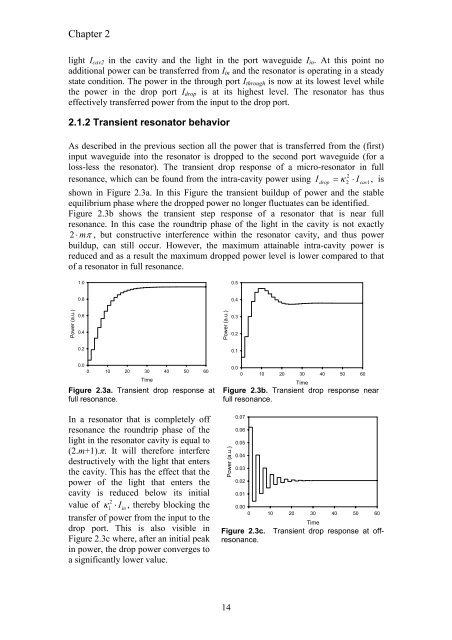Edwin Jan Klein - Universiteit Twente
Edwin Jan Klein - Universiteit Twente
Edwin Jan Klein - Universiteit Twente
Create successful ePaper yourself
Turn your PDF publications into a flip-book with our unique Google optimized e-Paper software.
Chapter 2<br />
light Icav2 in the cavity and the light in the port waveguide Iin. At this point no<br />
additional power can be transferred from Iin and the resonator is operating in a steady<br />
state condition. The power in the through port Ithrough is now at its lowest level while<br />
the power in the drop port Idrop is at its highest level. The resonator has thus<br />
effectively transferred power from the input to the drop port.<br />
2.1.2 Transient resonator behavior<br />
As described in the previous section all the power that is transferred from the (first)<br />
input waveguide into the resonator is dropped to the second port waveguide (for a<br />
loss-less the resonator). The transient drop response of a micro-resonator in full<br />
2<br />
resonance, which can be found from the intra-cavity power using I drop = κ 2 ⋅ I cav1,<br />
is<br />
shown in Figure 2.3a. In this Figure the transient buildup of power and the stable<br />
equilibrium phase where the dropped power no longer fluctuates can be identified.<br />
Figure 2.3b shows the transient step response of a resonator that is near full<br />
resonance. In this case the roundtrip phase of the light in the cavity is not exactly<br />
2 ⋅ mπ<br />
, but constructive interference within the resonator cavity, and thus power<br />
buildup, can still occur. However, the maximum attainable intra-cavity power is<br />
reduced and as a result the maximum dropped power level is lower compared to that<br />
of a resonator in full resonance.<br />
Power (a.u.)<br />
1.0<br />
0.8<br />
0.6<br />
0.4<br />
0.2<br />
0.0<br />
0 10 20 30<br />
Time<br />
40 50 60<br />
Figure 2.3a. Transient drop response at<br />
full resonance.<br />
In a resonator that is completely off<br />
resonance the roundtrip phase of the<br />
light in the resonator cavity is equal to<br />
(2.m+1).π. It will therefore interfere<br />
destructively with the light that enters<br />
the cavity. This has the effect that the<br />
power of the light that enters the<br />
cavity is reduced below its initial<br />
2<br />
value of κ 1 ⋅ Iin<br />
, thereby blocking the<br />
transfer of power from the input to the<br />
drop port. This is also visible in<br />
Figure 2.3c where, after an initial peak<br />
in power, the drop power converges to<br />
a significantly lower value.<br />
Power (a.u.)<br />
14<br />
0.5<br />
0.4<br />
0.3<br />
0.2<br />
0.1<br />
0.0<br />
0 10 20 30 40 50 60<br />
Time<br />
Figure 2.3b. Transient drop response near<br />
full resonance.<br />
Power (a.u.)<br />
0.07<br />
0.06<br />
0.05<br />
0.04<br />
0.03<br />
0.02<br />
0.01<br />
0.00<br />
0 10 20 30<br />
Time<br />
40 50 60<br />
Figure 2.3c. Transient drop response at offresonance.















